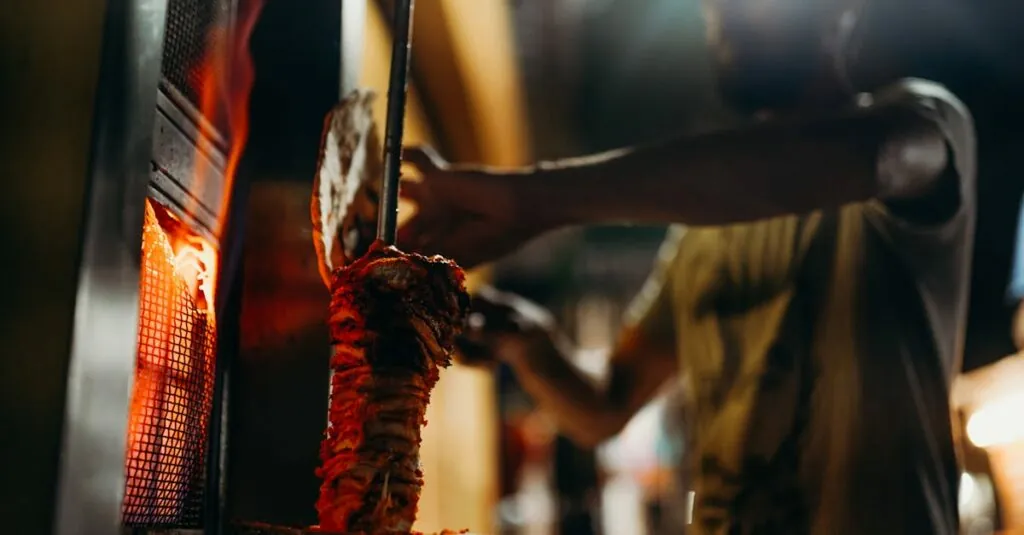Table of Contents
ToggleIndian cooking techniques are a vibrant tapestry of flavors, aromas, and traditions that transform simple ingredients into culinary masterpieces. From the sizzling sounds of tempering spices to the slow simmering of rich curries, these methods not only tantalize taste buds but also tell stories of culture and heritage.
Overview of Indian Cooking Techniques
Indian cooking techniques showcase a vibrant tapestry of cultural traditions. These methods transform simple ingredients into extraordinary dishes. Each technique acts as a storyteller, conveying heritage through flavors and aromas.
Tempering spices plays a critical role in infusing dishes with depth. This process entails briefly frying spices in hot oil. It releases essential oils, enhancing the overall taste and aroma of the meal. Stir-frying, another common method, quickly cooks vegetables and proteins at high heat, preserving their color and crunch.
Slow cooking, also known as Dum, allows flavors to meld beautifully. The technique involves simmering food at low temperatures for extended periods, ideal for curries and stews. This method softens ingredients while allowing spices to develop complex flavors.
Marination is essential for adding flavor and tenderness to meats and vegetables. By soaking ingredients in a mixture of spices and acids, cooks enhance texture and taste. The length of the marination process can vary from 30 minutes to several hours depending on the recipe.
Tandoori cooking, popular in North India, involves using a clay oven. This method imparts a unique smoky flavor that can’t be replicated easily. Naan and other bread items cooked in a tandoor develop a distinctive texture and taste, making them staple accompaniments.
Finally, steaming retains nutrients while cooking food gently. This technique is prevalent in South Indian cuisine, where dishes like idli and dosa showcase the benefits of steaming. By preserving the integrity of ingredients, steaming emphasizes their natural flavors.
These diverse techniques contribute to the rich culinary landscape, ensuring each meal serves as a delicious representation of Indian culture.
Regional Variations in Indian Cooking
Indian cooking showcases diverse regional techniques that reflect cultural nuances and flavors. Each area boasts distinct methods that elevate ingredients into remarkable dishes.
North Indian Techniques
In North India, cooking often involves techniques like tandoori and dum. Tandoori cooking uses clay ovens to impart a unique smoky flavor to meats and breads. Dum cooking allows complex flavors to develop slowly in sealed pots, resulting in aromatic biryanis and curries. Additionally, tempering spices, or tadka, is common, where hot oil releases essential oils from spices, enhancing the dish’s depth.
South Indian Techniques
South Indian cuisine features techniques such as steaming and tempering. Steaming preserves nutrients and emphasizes the natural flavors of ingredients, evident in popular dishes like idli and dhokla. Tempering appears in the preparation of sambar, a lentil-based dish often paired with rice. Moreover, the use of coconut in cooking adds a rich creaminess, frequently found in curries, enhancing overall taste profiles.
East Indian Techniques
In East India, techniques emphasize methods like slow-cooking and fish preparation. Slow-cooking allows the ingredients, particularly in curries, to meld flavors beautifully over time. Fish, a staple in the region, is often marinated and then cooked in mustard oil, lending a distinctive taste. Additionally, using panch phoron, a five-spice blend, adds complexity to many dishes, embodying the essence of Eastern flavors.
West Indian Techniques
West Indian cooking showcases techniques such as shallow-frying and pickling. Shallow-frying preserves the texture of vegetables and proteins, making dishes crisp and flavorful. Pickling plays a significant role, with a variety of spices used to create tangy condiments that accompany meals. Furthermore, regional specialties like dhokla and besan chilla highlight the versatility of legumes, often incorporated into everyday recipes.
Essential Cooking Tools and Equipment
Indian cooking employs a variety of tools and equipment that enhance the culinary experience. A karahi, a deep, round cooking vessel, is commonly used for frying and preparing curries. Its design promotes even heating, which is essential for many dishes.
A tawa serves as a flat griddle ideal for making roti and dosa. This tool provides a flat cooking surface that ensures even cooking, resulting in perfectly browned bread and crepes.
Using a pressure cooker speeds up cooking times for lentils and meats, making it a staple in many Indian households. It allows flavors to develop quickly while preserving moisture.
A mortar and pestle, known as a sil-batta, plays a crucial role in grinding spices and herbs. The traditional method releases essential oils, enhancing flavor profiles in recipes.
In every kitchen, a blender or mixer facilitates puree creation for sauces and chutneys. This equipment simplifies the preparation process by merging ingredients into a smooth consistency.
Specialized tandoors, clay ovens primarily used in North Indian cooking, create a unique smoky flavor in breads and meats. They impart a traditional touch that can’t be replicated by standard ovens.
Lastly, various utensils such as ladles, spatulas, and serving spoons are vital for cooking and serving. Their diverse designs accommodate different cooking techniques and ensure ease during meal preparation.
Together, these tools form the backbone of Indian cooking, enabling the execution of distinct techniques that transform meals into delightful representations of culture and tradition.
Common Ingredients and Flavors Used
Indian cuisine thrives on a rich array of ingredients and flavors that form its foundation. Spices play a pivotal role, with staples like cumin, coriander, turmeric, and garam masala defining various dishes. Each spice contributes unique notes, enhancing the overall flavor profile with warmth and complexity.
Legumes are another cornerstone of Indian cooking. Lentils, chickpeas, and kidney beans provide protein and texture in numerous recipes. Their versatility allows for a range of dishes, from hearty dals to savory curries, highlighting their importance in vegetarian cuisine.
Vegetables also feature prominently in Indian meals. Common choices include potatoes, eggplants, and spinach. Seasonal vegetables often accompany various preparations, ensuring freshness and vitality in each dish. These vegetables embrace spices, creating vibrant and flavorful combinations that resonate with diverse tastes.
Herbs add freshness and aroma to Indian food. Fresh cilantro and mint frequently garnish dishes, providing a refreshing contrast to spicy flavors. Incorporating these herbs highlights the importance of balance in Indian cooking, where each element interacts harmoniously.
Moreover, cooking oils contribute to the overall taste and health benefits. Mustard oil is prevalent in East Indian dishes, while ghee, a clarified butter, enhances richness in North Indian cuisine. Each oil reflects regional preferences, showcasing the diversity across Indian culinary traditions.
Finally, condiments such as chutneys and pickles offer bursts of flavor. Raw mango chutney and lime pickle serve as tantalizing accompaniments, often elevating simple meals. These condiments not only enhance dishes but also celebrate regional ingredients and culinary techniques.
Diverse ingredients and vibrant flavors create a rich tapestry in Indian cooking. Each component plays a vital role, contributing to the delightful experience of Indian cuisine.
Indian cooking techniques are more than just methods; they embody a rich cultural heritage that transforms everyday ingredients into extraordinary meals. Each technique tells a story, whether it’s the smoky allure of tandoori or the delicate flavors developed through slow cooking.
The diversity of regional practices showcases the adaptability and creativity inherent in Indian cuisine. From the vibrant spices that define flavor profiles to the essential tools that facilitate these methods, every aspect contributes to a culinary experience that’s both unique and deeply rooted in tradition.
Exploring these techniques opens a door to understanding the heart of Indian cooking, where every dish is a celebration of culture, community, and creativity.




